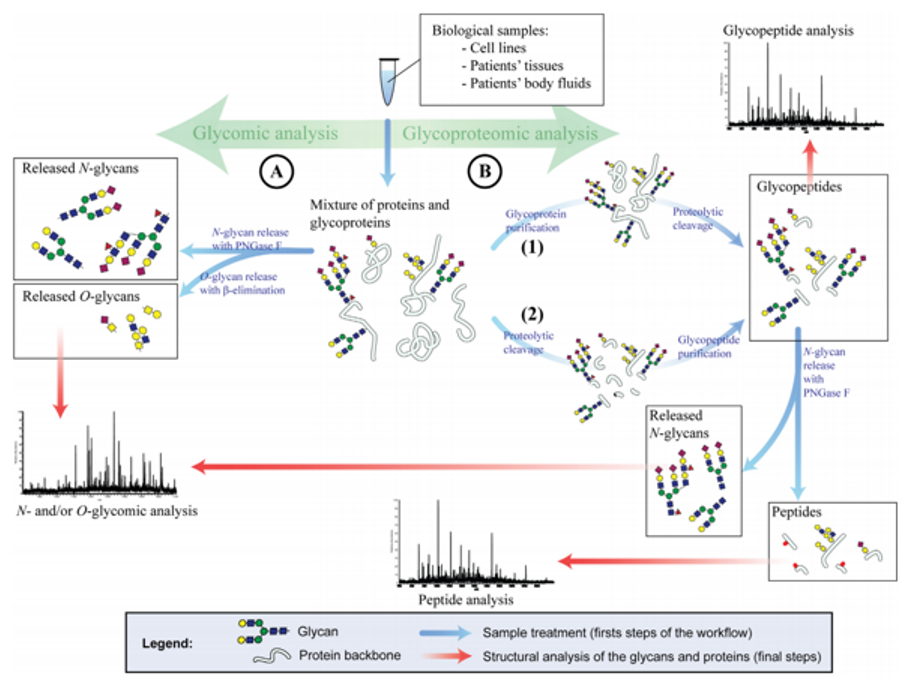v-innovate Technologies, relying on the advanced mass spectrometry, biochemical detection platform and experienced scientific research team, provides N-glycan, O-glycan, and other types of glycan metabolism analysis service in animal. v-innovate Technologies testing platform provides high-quality, fast and accurate one-stop testing service to support your scientific research.
Protein glycosylation is a common post-translational modification of proteins, which transports glycans to proteins and specific amino acid residues to form glycosidic bonds under the action of glycosyltransferase.
Glycosylation modification mainly occurs in endoplasmic reticulum and Golgi matrix. The main process is to transport the glycan linkage to the protein with the help of glycosyltransferase, and then form a glycosidic bonds with the amino acid residues on the protein. After a series of transport processes and pruning the end of the glycan linkage, fucosylation or sialylation modification is carried out to indicate that the assembly of glycosylated protein is completed.
 Fig 1. Glycomic and glycoproteomic strategies for glycan analysis (Mereiter, Balmana, Gomes, Magalhaes, & Reis, 2016).
Fig 1. Glycomic and glycoproteomic strategies for glycan analysis (Mereiter, Balmana, Gomes, Magalhaes, & Reis, 2016).
The main glycosylation types of proteins in mammals can be divided into two types: N-glycosylation and O-glycosylation, most glycoproteins contain only one type of glycosylation. However, some protein peptides have both N-glycan linkage and O-glycan linkage.
The N-glycosylation is covalently linking with the free -NH2 group of aspartic acid of the protein and the synthesis of N-linked glycans starts with the endoplasmic reticulum (ER), then completes in the Golgi apparatus.
The O-glycan linkage is covalently linked to the free -OH group of serine or threonine of the protein. There has no conservative sequence or fixed core structure on the O-glycosylation site. The O-glycan linkage can be composed of either a monosaccharide or a huge sulfonated polysaccharide, so the analysis of O-glycosylation is more complicated than that of N-glycosylation.
 Fig 2. Workflow of glycan metabolism service of v-innovate Technologies.
Fig 2. Workflow of glycan metabolism service of v-innovate Technologies.
| N-Glycan Profile | N-Glycan Biosynthesis | Various Types of N-glycan Biosynthesis | O-Glycan Profile |
| Mucin type O-glycan Biosynthesis | Mannose Type O-glycan Biosynthesis | Glycosaminoglycan Biosynthesis | Chondroitin Sulfate / Dermatan Sulfate |
| Heparan Sulfate / Heparin | Keratan Sulfate | Glycosaminoglycan Degradation | Glycosylphosphatidylinositol (GPI) |
| Anchor Biosynthesis | Glycosphingolipid Biosynthesis | Lacto and Neolacto Series | Globo and Isoglobo Series |
| Ganglio Series |
Repeated freezing and thawing of samples must be avoided. The serum sample should be precipitated in the collection tube for 30 minutes at room temperature, then transported to the centrifuge tube and centrifuged at 8000 rpm for 5 minutes. After centrifugation, the supernatant was equally divided into a freezing tube of 500 uL / sample.
Anticoagulants and preservatives must be added immediately after collection and then frozen at -80 °C.
Urine samples should be equally divided into centrifuge tubes with 1 mL per tube, each tube is added with 1/100 (w/v) sodium azide and stored at -80 °C.
Sample should be frozen in liquid nitrogen immediately and then transported to -80 °C for storage after collected.
Cytoactive should be terminated immediately to maintaining cell integrity.
In general, to assure enough sample to fulfill the whole project, the volume of the single sample need to be offered as much as possible. The remaining samples will be stored for one year free of charge and returned at any time if necessary. All samples need to be stored and transported at-80°C.
Clinical samples are repeated in no less than 30 cases in a single group.
Animal samples are repeated in no less than 9 cases in a single group.
v-innovate Technologies metabolism analysis platform is committed to the all-around, reliable and accurate analysis service for a variety of target substances, which is suitable for life science research, drug exploration, biological determination and other fields. We provide personalized metabolism analysis service to support your science research.
References
